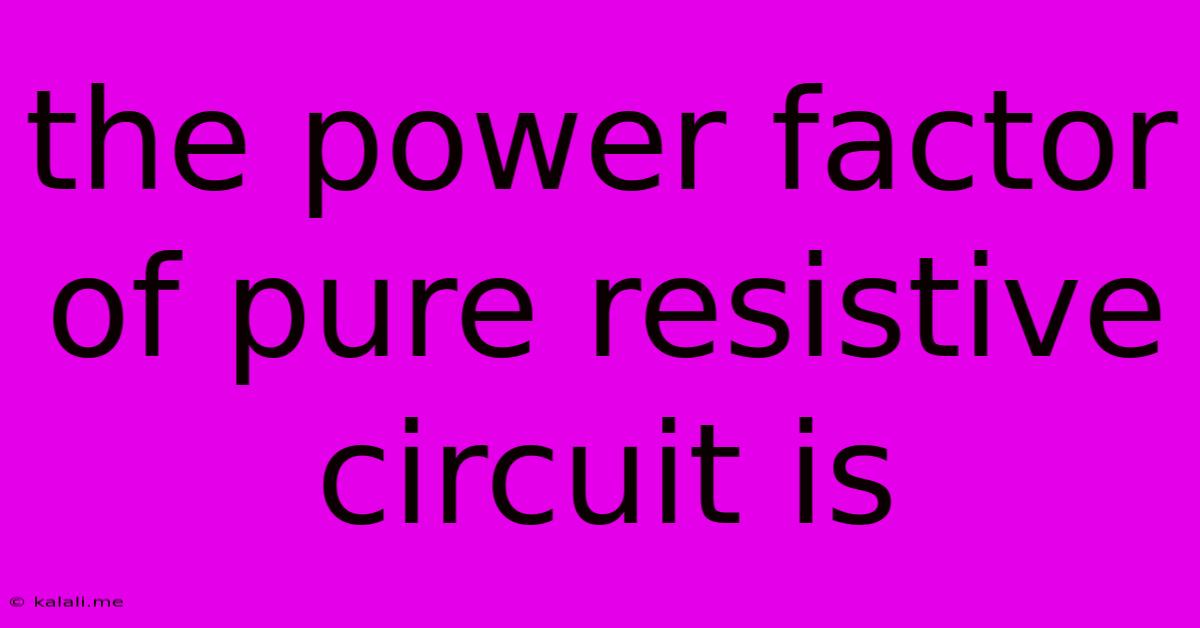The Power Factor Of Pure Resistive Circuit Is
Kalali
Jun 14, 2025 · 3 min read

Table of Contents
The Power Factor of a Purely Resistive Circuit: A Simple Explanation
Meta Description: Understanding power factor is crucial in electrical engineering. This article explains the power factor of a purely resistive circuit, highlighting its unique characteristics and contrasting it with inductive and capacitive circuits. Learn how resistance impacts power consumption and efficiency.
Power factor (PF) is a crucial concept in electrical engineering that describes the efficiency of electrical power usage. It represents the ratio of real power (kW) to apparent power (kVA) in an AC circuit. While often discussed in the context of inductive and capacitive loads, understanding the power factor of a purely resistive circuit provides a foundational understanding of this important concept.
In a purely resistive circuit, the current and voltage are in phase. This means they reach their peak values at the same time and their waveforms align perfectly. This simple relationship significantly impacts the power factor.
What is a Purely Resistive Circuit?
A purely resistive circuit is an idealized circuit containing only resistance (R). This means there's no inductance (L) or capacitance (C) present. Examples, though rarely perfectly pure in reality, include simple circuits with incandescent light bulbs, heating elements, or resistors.
Calculating Power Factor in a Resistive Circuit
The power factor is calculated using the following formula:
Power Factor (PF) = Real Power (P) / Apparent Power (S)
Where:
- Real Power (P): This is the actual power consumed and converted into useful work, measured in Watts (W) or kilowatts (kW). In a resistive circuit, it's calculated as: P = I²R = V²/R = VI (where I is current, V is voltage, and R is resistance).
- Apparent Power (S): This is the total power supplied to the circuit, regardless of how much is actually used. It's the product of voltage and current and is measured in Volt-Amperes (VA) or kilovolt-amperes (kVA). In a resistive circuit, S = VI.
Because the current and voltage are in phase in a purely resistive circuit, the real power (P) equals the apparent power (S). Therefore:
Power Factor (PF) = P / S = VI / VI = 1
This means the power factor of a purely resistive circuit is always 1, or 100%. This indicates perfect efficiency – all the supplied power is consumed as real power, with no reactive power component.
Comparing Resistive Circuits to Inductive and Capacitive Circuits
This contrasts sharply with circuits containing inductors (coils) or capacitors. In inductive circuits, the current lags behind the voltage, resulting in a power factor less than 1. In capacitive circuits, the current leads the voltage, again resulting in a power factor less than 1. These reactive components consume power but do not convert it into useful work, leading to energy loss.
Why is Power Factor Important?
A power factor of 1 is ideal. A lower power factor means more current is flowing in the circuit than is actually needed to do the work, leading to increased energy costs and potential equipment problems. Power companies often charge penalties for low power factors. Improving the power factor (through power factor correction techniques involving capacitors) is therefore often economically advantageous.
In conclusion, the power factor of a purely resistive circuit is a straightforward concept: it's always 1. Understanding this fundamental aspect of power factor lays the groundwork for understanding more complex AC circuits and the importance of power factor correction in optimizing energy efficiency.
Latest Posts
Latest Posts
-
What Is The Lcm Of 36 And 45
Jun 15, 2025
-
Compound Interest Formula Excel Between Two Dates
Jun 15, 2025
-
Difference Between Winter And Summer Olympics
Jun 15, 2025
-
The Missing Number In The Series 1 4 27
Jun 15, 2025
-
Least Common Multiple Of 60 And 72
Jun 15, 2025
Related Post
Thank you for visiting our website which covers about The Power Factor Of Pure Resistive Circuit Is . We hope the information provided has been useful to you. Feel free to contact us if you have any questions or need further assistance. See you next time and don't miss to bookmark.